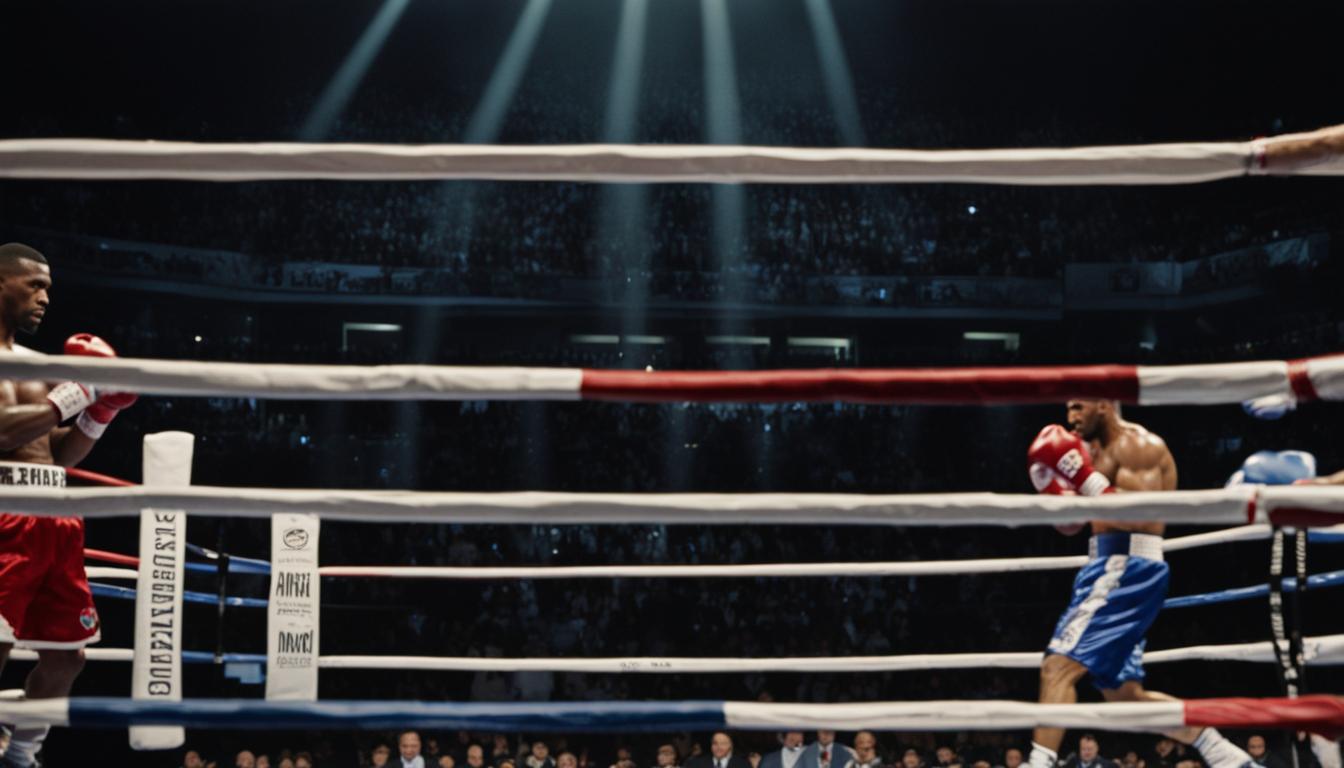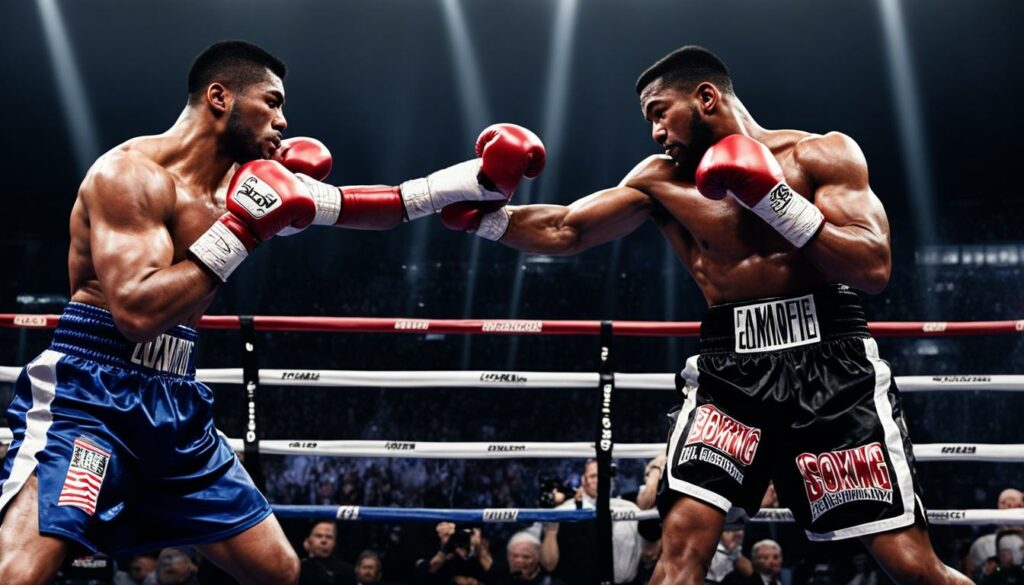As an avid fan of the sweet science, I’ve often found myself fascinated by the world of boxing. From the thundering punches to the strategic footwork, every aspect of the sport holds a unique charm. However, what many people may not realize is that boxing has two distinct levels of competition: professional and amateur. These two levels differ in various ways, ranging from rules and equipment to training techniques and weight classes.
In this article, we will explore the key differences between pro boxing and amateur boxing, shedding light on the nuances that set them apart. Whether you’re a passionate boxing enthusiast or considering stepping into the ring, understanding these differences can guide your journey and help you make informed decisions.
Key Takeaways:
- Professional boxing and amateur boxing have notable differences in rules, equipment, scoring system, and objectives.
- Pro boxing emphasizes knockouts and employs a 10-point scoring system, while amateur boxing focuses on accumulating points through clean, technical punches.
- The use of headgear, glove sizes, and round durations also differ between the two levels.
- Training techniques and weight classes are tailored to the specific demands of each level.
- Understanding the distinctions between pro boxing and amateur boxing can help aspiring boxers choose their path and set realistic goals.
Rules and Regulations
In the world of boxing, both professional and amateur levels have their own set of rules and regulations. Let’s explore the key differences between pro boxing rules and amateur boxing rules.
Counting the Knockouts
In professional boxing, fighters are given a 10 count by the referee if they are knocked down by a dangerous shot, allowing them a chance to recover and continue the fight. On the other hand, in amateur boxing, fighters only receive an 8 count before the match is stopped if they are deemed unable to continue.
Scoring System
The scoring system also differs between pro and amateur boxing. In amateur boxing, a 10-9 point system is used, taking into account factors such as competitiveness and tactical superiority. Each round is scored independently, with the winner of the round receiving 10 points and the opponent receiving 9 or fewer points based on their performance. In contrast, professional boxers aim for knockouts to secure victory. While points are still awarded, the ultimate goal is to deliver a powerful punch that knocks out the opponent.
Number of Rounds
The duration of fights varies between pro and amateur boxing. Amateur boxers typically compete in three-round bouts, allowing for a shorter and more intense fight. In contrast, professionals can go up to 12 rounds, showcasing their endurance, stamina, and skill over a longer period of time.
Understanding and following these rules and regulations is crucial for both professional and amateur boxers to compete effectively within their respective levels. Now that we’ve covered the rules and regulations, let’s delve into the equipment and gear used in pro and amateur boxing in the next section.
Equipment and Gear
Boxing is a sport that requires proper equipment to ensure the safety and performance of the athletes. Both professional and amateur boxers use specific gear tailored to their level of competition. Let’s take a closer look at the equipment used in pro boxing and amateur boxing:
Amateur Boxing Equipment
In amateur boxing, safety is a top priority. As a result, amateur boxers are required to wear headgear, larger gloves, and mouthguards during their bouts. The headgear protects against potential head injuries, while the larger gloves offer increased padding to reduce the impact of punches. Mouthguards are essential for safeguarding the teeth and jaw.
Professional Boxing Equipment
Professional boxing has different regulations regarding equipment. Unlike amateur boxers, professional fighters do not use headgear. However, they still wear mouthguards to protect their mouth and gums. Additionally, professional boxers use smaller gloves compared to their amateur counterparts.
Here is a breakdown of the key differences in equipment between pro boxing and amateur boxing:
| Equipment | Amateur Boxing | Professional Boxing |
|---|---|---|
| Headgear | Required | Not used |
| Gloves | Larger gloves with increased padding | Smaller gloves for increased impact |
| Mouthguards | Required | Required |
Both amateur and professional boxers compete in a ring with fairly similar dimensions. The standard ring size for boxing ranges between 16-24 feet, providing enough space for boxers to maneuver and engage in thrilling exchanges.
Now that we have explored the equipment and gear used in pro boxing and amateur boxing let’s move on to the next section where we will delve into the scoring and judging systems.
Scoring and Judging
Scoring in boxing is a crucial element that determines the outcome of a fight. However, the scoring systems differ between pro boxing and amateur boxing, reflecting the distinct objectives and priorities of each level.
Amateur Boxing Scoring System
In amateur boxing, the scoring system focuses on technical skill and precision. Judges assess the number of clean, technical punches landed by each boxer. Points are awarded for successful punches that connect with the opponent’s target area.
Amateur boxing scoring also takes into account factors such as effective defense, ring generalship, and sportsmanship. Points are deducted for blocked or missed punches, excessive clinching, or unsportsmanlike conduct. The goal for amateur boxers is to accumulate points throughout the fight and outscore their opponents.
Professional Boxing Scoring System
Professional boxing employs a ten-point must system, where judges assign a score for each round based on a range of criteria. The criteria include effective aggression, defense, clean and hard punching, and ring generalship. Knockdowns and powerful punches carry significant weight in the scoring process.
The ten-point system means that the winner of a round receives ten points, while the loser typically receives nine or fewer points. If one boxer dominates a round, they may receive a 10-8 score. In the event of a knockdown, the score can further shift to 10-7 or even 10-6 in the case of a knockdown accompanied by a point deduction.
At the end of the bout, the judges’ scores from each round are tallied to determine the winner. If the fight goes the distance, a decision is reached based on the majority or unanimous tally.
In professional boxing, the emphasis is on a fighter’s ability to showcase their skills and power, aiming for knockouts to secure decisive victories. The scoring system is designed to reward boxers who display superior technique, aggression, and control over the course of the fight.
Now let’s take a closer look at a comprehensive table comparing the key aspects of the scoring systems in pro and amateur boxing:
| Scoring Aspect | Amateur Boxing | Professional Boxing |
|---|---|---|
| Objective | Accumulating Points | Showcasing Superior Technique, Aggression, and Power |
| Criteria | Number of Clean, Technical Punches | Effective Aggression, Defense, Clean and Hard Punching, Ring Generalship |
| Point Deductions | Blocked or Missed Punches, Excessive Clinching, Unsportsmanlike Conduct | Varies, Including Knockdowns, Point Deductions, Unsportsmanlike Conduct |
| Judges’ Scorecards | Tally of Points for Each Round | Ten-Point Must System |
| Winner Determination | Total Points Accumulated | Majority or Unanimous Decision Based on Rounds Scored |
Understanding the scoring and judging systems in boxing is essential for both participants and fans. It provides insights into the criteria used to evaluate boxer performance and contributes to the excitement of the sport.
Conclusion
In conclusion, pro boxing and amateur boxing exhibit significant differences in terms of rules, equipment, scoring system, and the overall objective of the sport. These disparities are essential for aspiring boxers to comprehend as they determine which level of competition best aligns with their goals and aspirations.
Understanding the distinctions between pro boxing and amateur boxing is crucial in making informed decisions about pursuing a professional career or enjoying the amateur circuit. Both paths provide unique opportunities for growth and success in the dynamic world of boxing.
While pro boxing places a greater emphasis on knockouts and overall power, amateur boxing focuses more on technical skill and accumulating points. Professionals fight in longer rounds and have the freedom to choose when to engage or retreat, whereas amateurs usually compete in shorter rounds and have a limited count to recover from dangerous shots.
Additionally, the equipment and gear used in the two levels differ. Amateurs wear headgear, larger gloves, and mouthguards to prioritize safety, while professionals forego headgear but still utilize mouthguards and smaller gloves.


